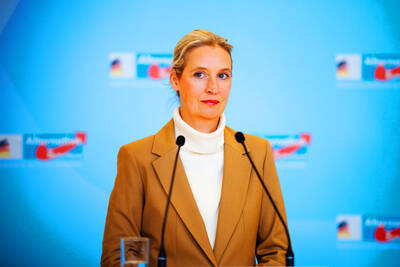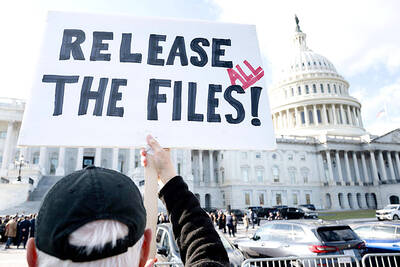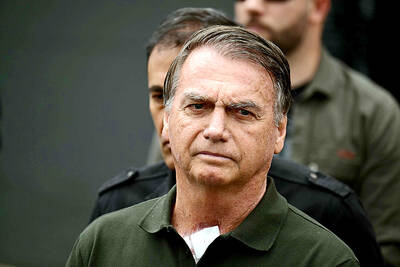With crucial elections next week, Nepal’s shaky peace process could implode if there is no decision as to what do with 20,000 hardened Maoist guerrillas, analysts and officials are warning.
The out-of-work fighters have been living in camps since the Maoists and political parties reached a peace agreement in November 2006 that placed rebel arms and troops under UN monitoring.
The Maoists want their force merged with the 90,000-strong national army, but Nepal’s interim prime minister and the army have other ideas, leaving the recruits — and, by extension, the peace process — in limbo, observers say.

PHOTO: AFP
“The success or failure of the peace process depends largely on settling the ex-guerrillas in a new life,” political analyst Bhasker Gautam said. “Only then will we be able to say that the war has completely ended.”
The Maoists, who launched their “people’s war” in 1996, mooted the idea of joining the national army shortly after mass protests by the political parties and the rebels forced Nepal’s autocratic king to cede power two years ago.
King Gyanendra — who sacked the government and seized direct control in February 2005, ostensibly to better deal with the violent insurgency — has been sidelined as the parties and former rebels formed an interim administration.
But the allies have squabbled over specifics, including what to do with the Maoist army, in the run-up to the April 10 polls for a body that will draft a new constitution and likely abolish the world’s last Hindu monarchy.
There is no sign yet of a committee that was to have been set up to look into the possibility of integrating Maoist fighters into the army.
The Maoists, fearful to tell their followers that the peace that ended a decade of war that saw 13,000 killed has made them jobless, are still calling for the forces to be unified.
“Integration into the army will take place. The leaders of the seven-party alliance [in the interim government] have made an agreement,” said Ananta, deputy commander of the People’s Liberation Army, the Maoist force’s official name.
“The Nepal army is under the government, so when the government decides to integrate the PLA into the army, the army will be obliged to do what the government tells them,” he said.
But early this year Nepalese Prime Minister Girija Prasad Koirala said a firm “no” to a merger, insisting the former rebels — steeped in extreme left-wing ideology — would “politicize” the regular army, which is also confined to barracks by the peace pact.
Yet the national army is hardly perceived as a neutral force itself — and political observers are echoing Maoist accusations that the military could yet step in to defend the embattled monarchy.
“An army takeover is a possibility as there are very few checks and balances any more between the state and the army,” a high-ranking military officer said on condition of anonymity.
Nepal’s army has had centuries of close links with the Himalayan country’s royal family and swore personal loyalty to the monarch until the caretaker government stripped him of his position as head of the army in May 2006.
The army’s current chief of staff, General Rookmangud Katawal, was adopted as a child by the royal Shah dynasty, leading many to see the force as a royalist bastion.
In recent months, Katawal has been seen as increasingly political and prone to making anti-Maoist statements, observers say.
Last month Koirala told the Election Commission that the regular army could be brought out of the barracks if pre-poll violence continues to increase, raising fears of fresh unrest.
By using the army for election security, Nepal would be “opening the door to army and People’s Liberation Army clashes,” said a Western diplomat who asked not to be identified.
“The sparks are all there,” the diplomat warned.
Some former rebel fighters have already been seen in uniform and bearing arms at campaign rallies, a violation of the peace agreement, the UN said on March 30.
Maoist leaders have promised they will order their soldiers to keep off the streets, the world body said.
But a high-ranking Nepalese military official warned that the former rebel army could not be contained in the camps forever.
“The People’s Liberation Army is a force that is young, indoctrinated and trained in arms,” the official said on condition of anonymity. “It’s a grave danger if they don’t find a place in society.”

A feud has broken out between the top leaders of the far-right Alternative for Germany (AfD) party on whether to maintain close ties with Russia. The AfD leader Alice Weidel this week slammed planned visits to Russia by some party lawmakers, while coleader Tino Chrupalla voiced a defense of Russian President Vladimir Putin. The unusual split comes at a time when mainstream politicians have accused the anti-immigration AfD of acting as stooges for the Kremlin and even spying for Russia. The row has also erupted in a year in which the AfD is flying high, often polling above the record 20 percent it

Ecuadorans are today to vote on whether to allow the return of foreign military bases and the drafting of a new constitution that could give the country’s president more power. Voters are to decide on the presence of foreign military bases, which have been banned on Ecuadoran soil since 2008. A “yes” vote would likely bring the return of the US military to the Manta air base on the Pacific coast — once a hub for US anti-drug operations. Other questions concern ending public funding for political parties, reducing the number of lawmakers and creating an elected body that would

The latest batch from convicted sex offender Jeffrey Epstein’s e-mails illustrates the extraordinary scope of his contacts with powerful people, ranging from a top Trump adviser to Britain’s ex-prince Andrew. The US House of Representatives is expected to vote this week on trying to force release of evidence gathered on Epstein by law enforcement over the years — including the identities of the men suspected of participating in his alleged sex trafficking ring. However, a slew of e-mails released this week have already opened new windows to the extent of Epstein’s network. These include multiple references to US President Donald

CHARGES: The former president, who maintains his innocence, was sentenced to 27 years and three months in prison for a failed coup bid, as well as an assassination plot Far-right former Brazilian president Jair Bolsonaro is running out of options to avoid prison, after judges on Friday rejected his appeal against a 27-year sentence for a botched coup bid. Bolsonaro lost the 2022 elections and was convicted in September for his efforts to prevent Brazlian President Luiz Inacio Lula da Silva from taking power after the polls. Prosecutors said the scheme — which included plans to assassinate Lula and a top Brazilian Supreme Court judge — failed only due to a lack of support from military top brass. A panel of Supreme Court judges weighing Bolsonaro’s appeal all voted to uphold